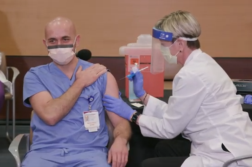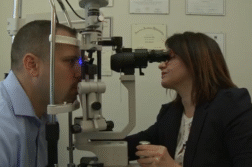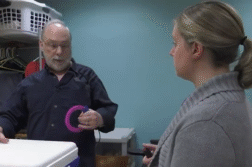ATLANTA, Ga. (Ivanhoe Newswire) – Imagine one day you notice your head, hands, leg or arms starting to shake – maybe it’s just a little, but then it starts to get worse. More than 10 million people have essential tremors. It can start small, but it can end up making it difficult to eat, speak, walk and talk. Now, a new treatment is helping to stop the shaking.
Janice Pedersen has a lot to live for – 11 kids and 52 grand kids to be exact.
“Michelle, Kristin, Lynette, Todd, Laura, Stephanie, Blake …,” Janice names.
But even before grandkids, Janice noticed her hands starting to shake – that’s when she was treated with MRI-guided high-frequency focused ultrasound.
Robert Gross, MD, PhD, neurosurgeon at Emory School of Medicine explains, “Using sound waves that get through the brain and create that, sort of, thermal heating, in the area that we’re trying to negate the activity. “
Dr. Gross can now pinpoint the tiniest area in the brain causing the tremors. Using the same type of ultrasound that breaks up kidney stones and allows you to see babies in utero, this one uses a thousand ultrasound beams to ablate, or destroy, the lesions in the brain causing the tremors.
“We focus those thousand beams such that, as they’re going through, they don’t do very much heating at any particular trajectory through the brain, but they all meet at a certain point,” Dr. Gross adds.
The FDA-approved procedure is now offered all over the country and is helping people like Janice to regain control of their lives.
The treatment is performed in a single session and usually takes two to three hours. It’s currently being used for patients living with essential tremor or Parkinson’s-related tremor that’s not responding to medication. Data so far shows the effect of the procedure lasts up to five years or longer.
Contributors to this news report include: Marsha Lewis, Producer; Matt Goldschmidt, Videographer; Roque Correa, Editor.
To receive a free weekly e-mail on medical breakthroughs from Ivanhoe, sign up at: http://www.ivanhoe.com/ftk
Source:
https://www.essentialtremor.org/wp-content/uploads/2013/07/FactSheet012013.pdf
MEDICAL BREAKTHROUGHS
RESEARCH SUMMARY
TOPIC: STOP SHAKING: FOCUSED ULTRASOUND TARGETS TREMORS
REPORT: MB #5379
BACKGROUND: Essential tremor is one of the most common movement disorders in the United States, characterized by involuntary trembling or shaking of the hands, arms, head, voice, or other parts of the body. They affect approximately 10 million people in the United States. While essential tremor is often benign and does not indicate a serious underlying condition, it can significantly impact an individual’s quality of life, affecting their ability to perform everyday tasks and activities. The hallmark symptom of essential tremor is involuntary shaking, which typically worsens with movement or when attempting to perform tasks requiring fine motor skills, such as writing, eating, or drinking. Tremors may also occur at rest but are usually more pronounced during voluntary movement. The exact cause of essential tremor is not fully understood, but it is believed to involve abnormalities in the brain circuits that control movement. Genetics may play a role, as essential tremor often runs in families. Environmental factors and certain medications may also contribute to the development or worsening of tremors.
DIAGNOSING: Diagnosing essential tremor involves a thorough medical history, physical examination, and evaluation of the characteristic symptoms. The diagnosis is typically based on the presence of bilateral, symmetric tremors that occur during voluntary movement and do not have an identifiable cause. Additional tests, such as blood tests or neuroimaging studies, may be performed to rule out other conditions that can cause tremors. Treatment options for essential tremor aim to reduce the severity of tremors and improve quality of life. Medications such as beta-blockers, anti-seizure medications, and benzodiazepines may be prescribed to help control tremors. In cases where medications are ineffective or poorly tolerated, other treatment options such as deep brain stimulation (DBS) surgery or focused ultrasound thalamotomy may be considered.
https://www.mayoclinic.org/diseases-conditions/essential-tremor/diagnosis-treatment/drc-20350539)
NEW TECHNOLOGY: A new form of treatment called focused ultrasound therapy is now being used more to treat patients struggling with essential tremors. The multiple beams that take place during ultrasound therapy work to target deep layers of the brain without damaging the surrounding tissue. This noninvasive and single treatment allows patients to recover very quickly and return to their normal daily activities as early as the next day after treatment.
FOR MORE INFORMATION ON THIS REPORT, PLEASE CONTACT:
Jennifer Johnson McEwen
If this story or any other Ivanhoe story has impacted your life or prompted you or someone you know to seek or change treatments, please let us know by contacting Marjorie Bekaert Thomas at mthomas@ivanhoe.com




